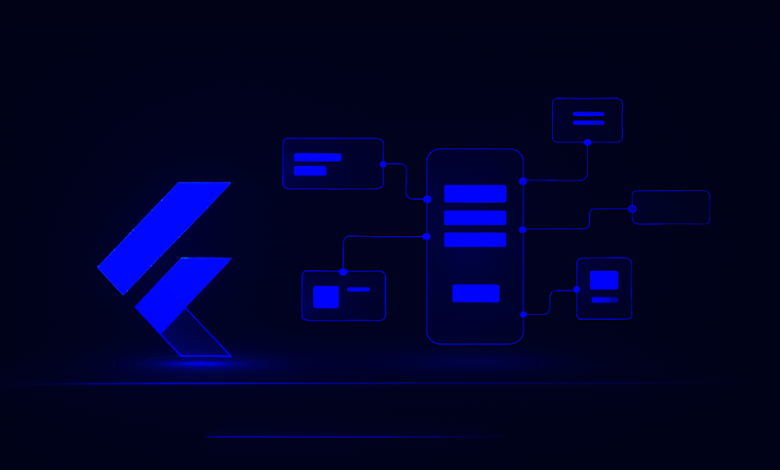Top Reasons Businesses Choose Flutter for High-Performance Web Apps

Web applications have come a long way from their early days as static, read-only portals. In today’s digital-first economy, they’ve evolved into dynamic, high-performance interfaces that power everything from enterprise dashboards to real-time collaborative platforms. For Web Apps users whether employees, partners, or customers. The web has become more than a destination. It’s a primary interaction point, and their expectations have changed accordingly.
In 2025, the bar is higher than ever. Users now expect web apps to behave like native mobile apps: fast load times, buttery-smooth animations, offline support, and seamless responsiveness across all devices. Whether they’re accessing a client portal, tracking live metrics, or managing complex workflows in the browser, performance, usability, and visual polish are non-negotiable.
This evolution has exposed the limitations of traditional frontend stacks:
- Teams often juggle separate codebases for web and mobile platforms.
- Developers wrestle with CSS inconsistencies, browser compatibility issues, and piecemeal third-party libraries.
- UI/UX fidelity is difficult to maintain across platforms, especially with limited design control in HTML/CSS.
These technical challenges don’t just frustrate developers. They slow down product teams, increase QA cycles, and inflate budgets. And in a world where speed to market is a strategic advantage, every inefficiency becomes a liability.
That’s where Flutter for web apps steps in.
Originally introduced by Google as a mobile development SDK, Flutter has matured into a full-scale cross-platform UI framework that can now target web, desktop, mobile, and even embedded systems all from a single codebase. But more importantly, Flutter doesn’t just promise code reusability; it redefines how apps are architected and delivered.
For modern businesses, selecting Flutter for web app development isn’t merely a choice between frameworks, it’s a bet on a development model that unifies platforms, accelerates delivery, and ensures design precision without compromise.
In this new web frontier, the winners are those who build once, launch everywhere, and look great doing it. Flutter offers exactly that.
Flutter for Web: A Quick Primer
Before diving into why so many businesses are making the switch, it’s important to understand what Flutter for web actually is and why it stands apart from traditional frontend frameworks.
At its core, Flutter is built with Dart, a client-optimized programming language developed by Google. Dart compiles ahead-of-time (AOT) into efficient machine code for mobile and into JavaScript or WebAssembly for the web, ensuring high performance across all platforms.
When you build for the web in Flutter, your application is compiled to HTML, CSS, and Canvas, and rendered using one of two backends. As more businesses adopt Flutter for their development needs, Flutter web app development services are becoming increasingly popular for creating fast, responsive web applications that integrate smoothly with mobile versions, streamlining the entire development process across platforms.
- DomCanvas: Ideal for simpler, lighter apps, this renderer translates Flutter widgets into DOM elements. It’s faster to load but less powerful for complex, graphics-heavy applications.
- CanvasKit: A WebAssembly-powered backend that uses Skia (the same rendering engine behind Chrome and Android) to draw every pixel. This offers high-fidelity visuals, advanced animations, and performance approaching native apps.
This architecture gives Flutter complete control over the UI. Unlike React or Angular, which rely on the browser’s layout engine and CSS rules, Flutter renders everything from scratch. Buttons, animations, shadows, transitions. They all behave exactly the same on Chrome, Safari, Firefox, and Edge.
When Should You Use Flutter for Web Apps?
Flutter for web isn’t meant to replace every type of website. It’s optimized for app-like experiences rather than traditional content-heavy pages. It excels in scenarios where interactivity, real-time updates, and consistent UI are key.
Here are the most common (and high-impact) use cases:
- Real-Time Dashboards
Think live metrics, charts, or financial reports that need fast updates and smooth animations. - Internal Tools and Admin Panels
Business back-office tools where UX consistency and quick deployment are critical. - B2B Platforms and CRMs
When you want the same rich experience across devices, including web access from laptops. - Interactive Progressive Web Apps (PWAs)
Flutter’s ability to deliver installable, offline-capable apps makes it a strong PWA contender. - Custom Portals with Brand-Specific UIs
Want your partner/vendor/customer portal to mirror your mobile app’s look and feel? Flutter nails that. - Mobile-First Apps That Need a Web Companion
If you already have a Flutter mobile app, adding a web version is straightforward with minimal code rewrite.
In short, Flutter doesn’t treat the browser like a page renderer. It treats it like a canvas. This opens up a whole new design and performance paradigm, letting developers build immersive, fluid, and highly responsive web experiences that feel more like native apps than traditional websites.
For businesses, this translates to consistent branding, faster delivery, and a seamless user experience across platforms, all from a single codebase.
10 Reasons Why Businesses Choose Flutter for Web Apps
As businesses continue to seek faster, more efficient ways to develop cross-platform applications, Flutter for web has emerged as a compelling solution. With its ability to deliver high-performance, responsive web apps from a single codebase, Flutter is quickly becoming a top choice for companies aiming to streamline development processes and enhance user experiences. In this section, we’ll explore the top 10 reasons why businesses are choosing Flutter for web apps, and how it can help them stay ahead in today’s competitive digital landscape.
1. Unified Codebase for All Platforms
One of Flutter’s most compelling advantages is its ability to write once, run anywhere. A single codebase can power your web app, iOS app, Android app, and even desktop clients — without duplicating logic or UI.
For businesses, this means:
- Drastically reduced development time and cost
- Smoother feature parity across platforms
- Easier team management one team, one tech stack
💡 Example: A startup can launch a fitness tracking platform using Flutter to deploy web and mobile apps together potentially the startup can save an estimated 45% in engineering cost and 2 months in dev time.
It’s a strategy that simplifies your tech stack, cuts delivery time, and unifies product experience across every touchpoint.
2. Lightning-Fast Development Cycles
Flutter’s hot reload, modular widget system, and integrated dev tools create a truly agile development environment. Developers can see UI changes in real-time, iterate faster, and debug visually all without recompiling the entire app.
This agility is a game-changer for:
- Iterating quickly on feedback
- A/B testing UI layouts
- Shipping updates at startup speed
For teams working under tight deadlines or rapid release schedules, Flutter unlocks faster product evolution with less friction.
3. Pixel-Perfect UI Control
Unlike traditional web frameworks that rely on the browser’s native DOM and CSS engine, Flutter gives you full control over every pixel on the screen. Every element is a widget that Flutter renders itself, leading to:
- Fully consistent UIs across browsers
- Brand-perfect visual identity
- Smooth animations and transitions without third-party hacks
Flutter ensures your web app looks and behaves exactly the way you envisioned on every screen, without surprises.
4. Near-Native Performance on the Web
Performance is critical. Whether you’re building a customer-facing PWA or a heavy internal analytics dashboard, speed matters.
Flutter’s CanvasKit renderer, built on WebAssembly and powered by Skia, enables:
- High frame rates (60fps+)
- GPU-accelerated rendering
- Faster Time to Interactive (TTI) than traditional JS-heavy SPAs
The result? Smooth, snappy apps that users love to engage with without the performance pitfalls of bloated JavaScript bundles.
5. Seamless Integration with Modern Backends
No web app exists in isolation, it needs to communicate with databases, authentication layers, APIs, and real-time services to truly deliver value. Flutter for web makes backend integration smooth and flexible, allowing developers to build complex, data-driven applications without friction. Whether you’re working with cloud-native services or custom enterprise stacks, Flutter provides the tools and compatibility to make it work out of the box.
Flutter web works out of the box with:
- Firebase (auth, Firestore, storage, hosting)
- Supabase (open-source Firebase alternative)
- REST APIs, gRPC, GraphQL
- WebSockets, local storage, and more
This makes it ideal for:
- Real-time dashboards
- SaaS platforms
- Live tracking or data entry tools
✅ Use Case: A logistics company built a Flutter web app for fleet managers to monitor real-time vehicle positions integrated via WebSockets and Supabase, all within weeks.
Flutter plays well with modern backend infrastructure, giving you the freedom to plug in real-time logic, analytics, and cloud workflows with ease.
6. Reduced Maintenance & QA Overhead
Managing separate codebases for mobile and web creates a long tail of maintenance: bugs to fix in two places, regression testing across devices, feature rollout coordination the list goes on.
With Flutter:
- One fix or feature update rolls out to all platforms
- Fewer chances for platform-specific bugs
- QA cycles are faster and more unified
This not only simplifies the testing workflow but reduces long-term technical debt freeing teams to focus on new features, not firefighting.
7. Strong Community & Ecosystem Support
Backed by Google and supported by a rapidly growing global developer community, Flutter continues to evolve at an impressive pace. Its thriving ecosystem, active forums, and frequent contributions make it one of the most future-ready frameworks available today:
- Over 30,000 packages on pub.dev
- Well-maintained plugins for web compatibility
- Rapid updates and clear long-term roadmaps
Whether you’re looking for a payment plugin, video renderer, or form validator chances are the Flutter ecosystem already has a solution that works across web and mobile.
8. PWA-Ready Out of the Box
Want your web app to behave like a native app installable, fast, and offline-ready?
Flutter supports Progressive Web App (PWA) features by default:
- App shell architecture
- Add to Home Screen prompt
- Service workers for offline caching
- Push notifications via Firebase or other tools
It’s a fast-track to building app-like experiences directly in the browser all without the overhead of managing native binaries.
9. Cost-Efficient Scaling
Whether you’re a fast-moving startup racing to launch your MVP or an established enterprise optimizing internal systems, the value of development efficiency can’t be overstated. It directly impacts time-to-market, operational costs, and the ability to scale without bloating engineering resources.
Flutter reduces costs across:
- Development (fewer engineers)
- Testing (one QA pass for all platforms)
- Deployment (centralized build & release cycles)
- Maintenance (one source of truth)
Lower overhead means higher agility and more budget for growth, experimentation, or expanding feature sets.
10. Future-Proof and Actively Evolving
Flutter is not a fringe framework, it’s a mature, production-grade technology backed by one of the most influential tech companies in the world. With consistent investment from Google, a clear multi-year roadmap, and growing adoption across industries, Flutter is built not just for today’s use cases but to power the next generation of cross-platform experiences.
Recent and upcoming updates:
- Dart 3 with sound null safety and WASM support
- Performance improvements in DOM renderer
- Better SEO and accessibility capabilities for Flutter Web
- Official support for web in production use cases
Choosing Flutter means you’re building on a platform that’s actively improving with Google’s backing, strong community momentum, and a future-focused roadmap.
Conclusion: Flutter Isn’t Just Mobile Anymore — It’s the Future of Web Apps
As digital ecosystems grow more interconnected and user expectations push the boundaries of performance and design, the line between mobile apps and web applications has all but disappeared. Today’s users expect continuity. They want to start a workflow on their desktop browser and complete it on their phone without skipping a beat. They want apps that feel smooth, react instantly, and look impeccable regardless of platform.
This unified expectation has forced businesses to confront a painful truth: managing separate teams, codebases, and UI systems for mobile and web is not only inefficient. It’s unsustainable. Flutternest helps businesses address this challenge by leveraging the power of Flutter, enabling seamless cross-platform development and a unified user experience across mobile and web.
Enter Flutter
What began as a mobile SDK has now evolved into one of the most powerful cross-platform UI toolkits of this era. Flutter enables teams to build once and deliver everywhere with full control over every pixel and interaction. But beyond the technical perks, it offers something far more strategic: agility at scale.
- Startups can rapidly prototype and release MVPs without waiting on parallel web and mobile pipelines.
- Enterprises can modernize outdated internal systems with rich, consistent UI across platforms.
- Product teams can iterate faster, test features simultaneously across form factors, and unify their user experience.
The advantages extend beyond development. With a single source of truth, QA becomes faster, bug tracking becomes more effective, design consistency becomes easier, and updates roll out across platforms simultaneously. In a world where user experience is a direct business differentiator, this level of cohesion is no longer a luxury it’s a necessity.
Flutter for web apps doesn’t just fill a gap in your tech stack. It transforms it. It’s not about choosing a web framework. It’s about choosing a new philosophy of product delivery: one that values speed without trade-offs, scale without fragmentation, and beauty without compromise.
In that light, selecting Flutter for web app development isn’t just a tactical decision. It’s a forward-looking commitment to building smarter, faster, and better.
So if your next web app needs to be modern, performant, and built to scale. Flutter may not just be a compelling option.
It may be your competitive edge.




